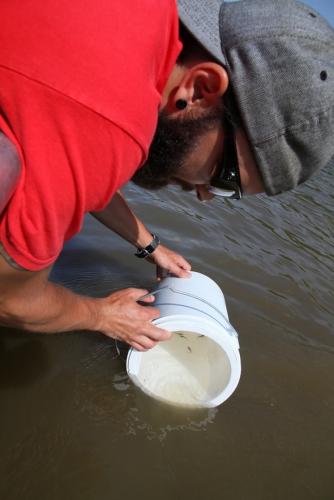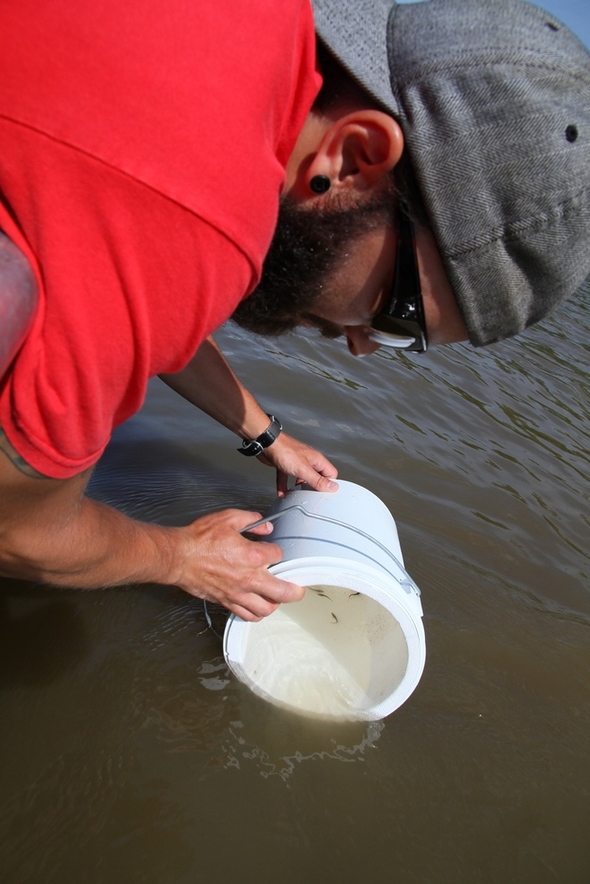
Xplor reconnects kids to nature and helps them find adventure in their own backyard. Free to residents of Missouri.


































Stay in Touch with MDC news, newsletters, events, and manage your subscription

Xplor reconnects kids to nature and helps them find adventure in their own backyard. Free to residents of Missouri.

A monthly publication about conservation in Missouri. Started in 1938, the printed magazine is free to residents of Missouri.


WEST ALTON, Mo. — Another successful chapter in the recovery of lake sturgeon in Missouri has recently been written. Lake sturgeon fry, hatched and raised in the lab from eggs collected at Missouri's first documented spawning in the wild, were released back into the Mississippi River May 29.
Lake sturgeon were once common in our big rivers, but by the 1970s overharvest and river habitat decline caused their numbers to plummet dramatically. The Missouri Department Conservation (MDC) made it a priority to save the species as part of its commitment to sustain healthy fish populations. MDC listed the species as a state endangered fish in 1974 and banned their harvest. In 1984, MDC staff began to raise them in Department hatcheries and release fingerlings from eight to ten inches into Missouri rivers.
For more than three decades, MDC staff looked for signs that the fish were on their way back through natural breeding. They got those signs last April through a video shot by Sam Hardy of St. Peters. While snagging for paddlefish near West Alton on the Mississippi River, Hardy and girlfriend Kristin Biagioli saw what they thought were lake sturgeon spawning. They used a smartphone to capture video of the behavior and reported it to MDC.
Two days later, MDC staff arrived to examine the site. John Buszkiewicz, a graduate student at Southeast Missouri State University working with MDC on the lake sturgeon recovery project, was among the team. He was joined be Debbie Sinha, MDC Resource Science Field Station Supervisor Dave Herzog, and volunteer Cristina Saldivar. The group found eggs that had been deposited on rocks along the bank. They brought them back to an MDC lab in Cape Girardeau to see if they would hatch. This would determine if successful spawning had taken place.
Four days later, the eggs hatched and the first successful reproduction of lake sturgeon in Missouri's rivers was confirmed.
From the start, the team planned to eventually release the lake sturgeon fry back into the wild. "We wanted to focus on the habitat where they'd have the best chance of survival," said Buszkiewicz. Normally where they end up being is the side channels of downstream island tips."
Buszkiewicz said river islands are crucial to lake sturgeon for feeding and growing at this stage of life. So it was important to release the fry into appropriate habitat in the Mississippi River near where they were spawned.
Buszkiewicz and his team choose a spot down river from the spawning site, at the downstream tip of the side channel of Maple Island. With a depth of about 12 feet and plenty of submerged vegetation, Buszkiewicz and team determined the flow level in the area was also appropriate.
Buszkiewicz removed the lid from the Styrofoam bait bucket in which the fry were transported, dipped it into the water, and allowed the lake sturgeon fry to swim off to a new life in the Mississippi River.
When asked how he felt about the release, Buszkiewicz admitted to having mixed emotions. "I was feeding them twice a day, so I'll miss them. But I'm happy overall because we got to put them back."
The new fry will now embark on the slow journey toward reproduction. At the time of release, the fry were 6 weeks old and approximately 1.25 inches long. Giant lake sturgeon can to grow to lengths approaching eight feet and weigh as much as 200-300 pounds. But that will take some time. The fish require 25-30 years to arrive at reproductive maturity. They are a long-lived species and can reach ages of 100-150 years. Lake sturgeon are also ancient fish. They evolved for more than 150 million years ago, during the time of the dinosaurs -- and they have outlived those giant reptiles.
As for the next chapter in their history, Buszkiewicz forecasts a bright future for lake sturgeon in Missouri. "I think they've got a pretty big chance with all the conservation efforts going on with MDC and all over North America.....It's a slow process, but I think within the next few decades we'll start to see some increase in numbers for sure."
For more information on lake sturgeon and MDC's recovery plan, visit mdc.mo.gov/node/1003.